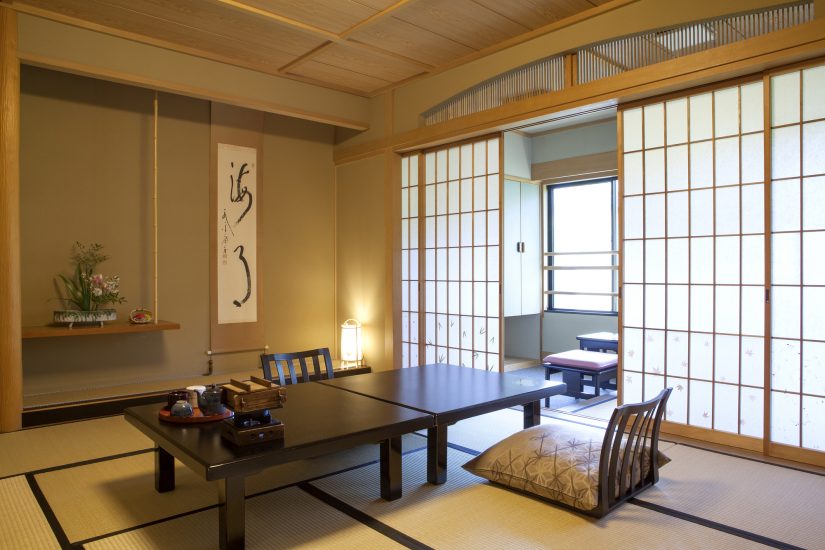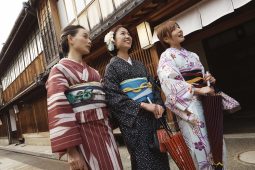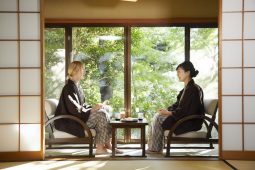If you have ever seen Yasujiro Ozu’s classic movie Tokyo Story, you will have noticed that its most striking aspect is its perspective. Everything is filmed from the level of the floor. This was a deliberate choice of Ozu who wanted to bring his audience down to the level of his characters. In a traditional Japanese home people sit directly on the tatami mat floor, so that’s where most of the movie’s dialogue occurs. So famous is the low angle perspective of Ozu’s movie that it has become known as the “tatami mat shot”. It also tells us a lot about Japanese interior design: everything is seen from a seated position on the floor, and the world does look very different from that angle.
Tatami mats are the traditional flooring material for Japanese homes. Made from woven rush straw they have a soft and gentle springiness that makes them a comfortable base for cushions or futons. In the past most rooms of the house would have been floored with tatami. These days it is usually reserved for special areas: a bedroom, guest room, or a formal wa-shitsu (traditional Japanese style room). Nevertheless, even in modern apartments a tatami room is not uncommon, and the size of a room is still measured by how many mats can fit inside it.
The use of tatami as flooring has also determined the kind of furniture Japanese people use. Zabuton are floor cushions used for seating. Chabudai are low short-legged tables used for taking tea or dining. Zaisu are low Japanese chairs with a back rest but no legs. Kotatsu, which are used in the winter, are low tables with a heater underneath and a quilt around the sides to retain the heat. At night futons can be pulled out and placed directly on the tatami because the natural springiness of the straw mat material is as good as any mattress. Indeed, for Japanese people tatami is so strongly associated with the comforts of home that it is not uncommon for people to say something like「畳の上で死ねたら幸せだ」– I would be happy to die on tatami.
Another aspect of traditional Japanese interiors is adaptability. A large room can be converted into separate rooms by simply adding sliding doors called fusuma. These doors are like movable walls. When you need a larger space again, you can simply take them away. Shōji are another type of sliding door made of translucent paper on wooden frames. They give a degree of privacy but also allow soft natural light to flow into the room. Yukimi shōji have a sliding panel at their base behind which is a sheet of glass. Yukimi literally means “snow-viewing,” so this type of screen allows you to stay warm inside while viewing the outer winter scene. Other portable room dividers are tsuitate partitioning screens, and byōbu which are folding screens.
Long before the invention of air conditioning, Japanese homes were designed to maximize air circulation, which was particularly important in the muggy summer months. Ranma are wooden transoms, usually above a fusuma which have openings to allow the free flow of light and air between rooms. Ranma are very often beautifully carved and add an ornate touch to otherwise simple interiors.
In a formal wa-shitsu, both furnishings and decorations are kept to a minimum. Artistic items, such as ikebana flower displays, bonsai trees, or kakejiku hanging scrolls, are usually placed in a corner alcove called the tokonoma. Tokonoma are inset into the wall and have a wooden pillar on one side called a tokobashira. The tokobashira is very often a highly polished tree trunk with its bark removed but its natural shape intact, which adds a sensual element to this formal space. Oddly enough the traditional place for a guest to sit when visiting a Japanese home is with their back to the tokonoma. This is because the host should be humble about their own display and not show it off too obviously.
All around the traditional Japanese room are the soft colors of earthern walls, paper screens, and bamboo or wooden finishes. Lighting is usually gentle too and provided by paper-covered andon lamps or ceramic lanterns called katō. The overall effect is soothing, peaceful, and calm.
Should you spend some time in Japan, then at some point you will encounter these interior design elements. We hope you too can enjoy this “tatami shot” perspective!








